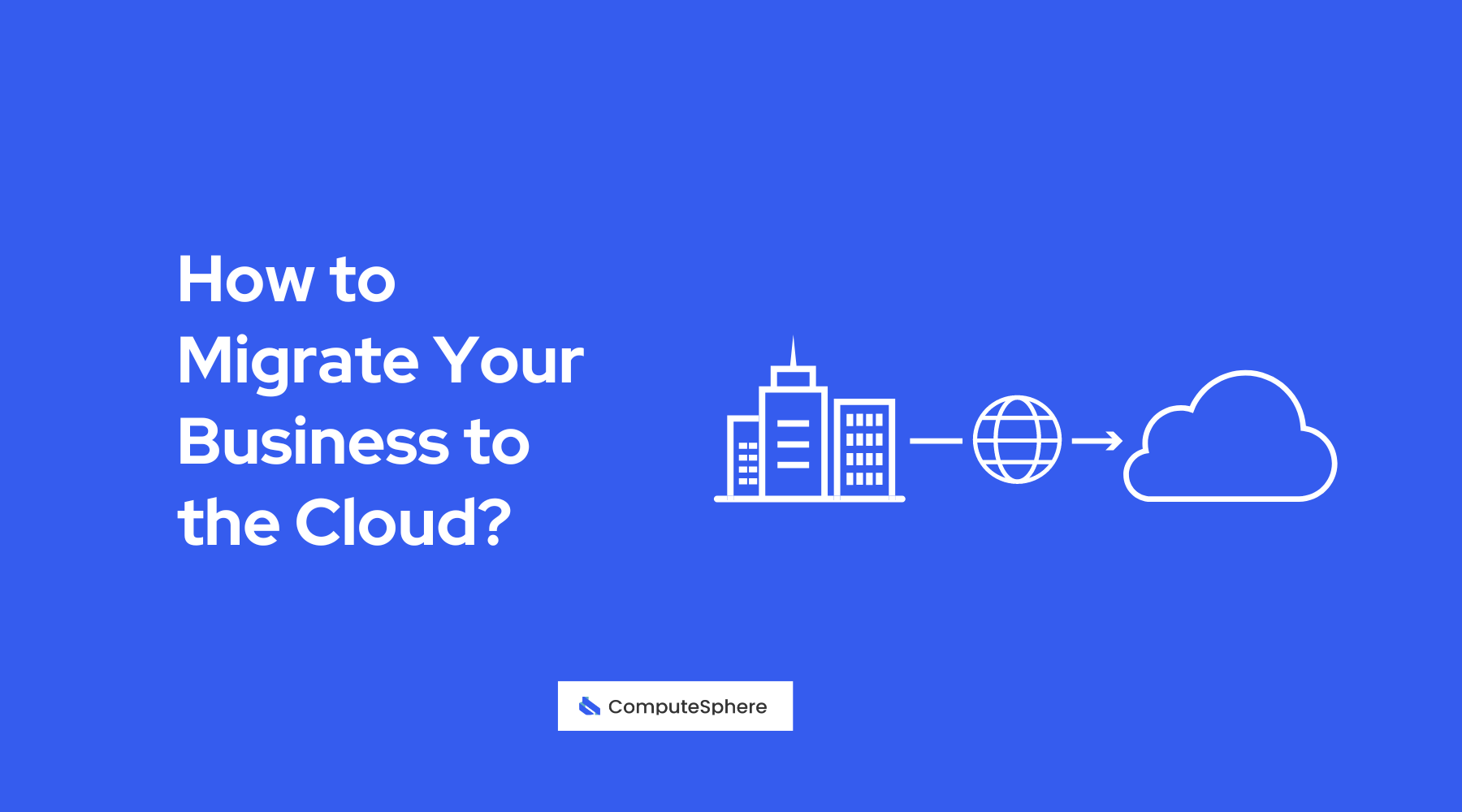How to Migrate Your Business to the Cloud?

Cloud hosting is becoming an important part of IT infrastructure for today's businesses. With the increasing amount of data and applications and the demand for remote work, having on-premise servers creates significant challenges including cost and scalability. That's why business are migrating their IT infrastructure to the Cloud. This process of moving from an in-house IT infrastructure to a cloud hosting service is called Cloud migration.
By migrating to the cloud, businesses can have access to advanced technologies and focus more on innovation rather than maintaining complex infrastructure. In the article below, explore the strategies and steps about how to migrate your business to the cloud to ensure a smooth and successful transition for your business.
What is Cloud Migration?
Cloud migration is the process of moving data, applications, and IT resources from on-premises infrastructure to a cloud-based environment. This shift allows organizations to get the scalability, flexibility, and cost-efficiency offered by cloud service providers. By migrating to the cloud, businesses can reduce their dependency on physical hardware, improve access to the latest technologies, and enhance their ability to quickly respond to changing market demands.
In essence, cloud migration is about transforming the way companies manage and deploy their IT resources. It enables them to focus more on innovation and growth rather than on maintaining complex, costly infrastructure. This strategic move can lead to increased productivity, better collaboration, and more robust security measures, ultimately driving business success in the digital age. Google Cloud, Microsoft Azure, and Amazon Web Services (AWS) are among the famous companies that provide cloud hosting to businesses.
Why Cloud Migration is Important For Your Business?
Cloud migration is important for modern businesses because it offers many that can significantly enhance their operations and competitiveness. Here are some key reasons why cloud migration is important:
Cost Efficiency: Reduces the need for expensive on-premises hardware and maintenance, allowing businesses to pay only for the resources they use.
Scalability: Provides the flexibility to easily scale resources up or down based on demand, ensuring optimal performance during peak times.
Accessibility: Enables access to data and applications from anywhere, facilitating remote work and improving collaboration among team members.
Innovation: Grants access to the latest technologies and tools, fostering innovation and helping businesses stay ahead in a rapidly evolving market.
Disaster Recovery: Enhances disaster recovery capabilities with robust backup solutions, ensuring data integrity and minimizing downtime during unexpected events.
Security: Offers advanced security measures and compliance certifications, protecting sensitive information and maintaining regulatory standards.
How to Migrate Your Business to the Cloud?
Migrating your business to the cloud involves a structured approach to ensure a smooth transition and minimal disruption. Here are the four key phases of cloud migration:

Migrating your business to the cloud involves a structured approach to ensure a smooth transition and minimal disruption. Here are the four key phases of cloud migration:
Assessing Your Business Needs
Begin by evaluating your current IT infrastructure and identifying which applications and data should be moved to the cloud. This assessment helps determine the best cloud solutions tailored to your business requirements.
Planning the Migration
Create a detailed migration plan that includes timelines, budget considerations, and potential risks. Involve key stakeholders and establish clear objectives to guide the process.
Preparing for Migration
Prepare your data and applications for the move by optimizing and testing them in a cloud environment. Ensure all necessary security measures and backups are in place to protect your assets.
Migrate
Execute the migration according to your plan, closely monitoring the process to address any issues that arise. Post-migration, verify that everything functions correctly and provide training for staff on the new system.
What are Cloud Migration Process Strategies?
Cloud migration process strategies are essential for successfully transitioning an organization's data, applications, and IT resources to the cloud. These strategies provide a roadmap to ensure a smooth and efficient migration, minimizing risks and disruptions. There are different migration strategies a few for data migration and others for application migration.
Data Migration Strategies
Data migration is a key component of this procedure. If users cannot access your data during the relocation, your business operations may suffer. The same goes for syncing and updating your systems after the initial migration. There are 2 types of data migration strategies you can apply. Here are the brief explanations for them.
Lift and Shift
As the name shows, it is just lifting and shifting. All you need is to move the stack from on-premises to the cloud. You can move the exact clone to your environment without making any changes to it. Companies with a conservative culture or no long-term strategy for leveraging modern cloud capabilities are ideal candidates for lift and shift strategy.
Refactoring
Refactoring, also known as rearchitecting. It is the process of recreating your applications from scratch. This is frequently motivated by a business need to exploit cloud capabilities that are not currently available in your environment. For example, cloud auto-scaling or serverless computing. Refactoring is typically the most expensive solution, but it is also the most compatible with subsequent versions.
Application Migration
Application migration to the cloud is different from data migration, but here are 2 most implemented strategies.
Rehosting
Rehosting is the process of moving programs and software components from one infrastructure to another without significantly changing the underlying architecture.
The goal of rehosting is to "tinker" with the existing infrastructure and move it to a new environment with as little disruption as possible, which may be done using both cloud-based and on-premises technology.
Replatforming
This is almost the same as lift and shift, but it extends further. It further optimizes your landscape for the cloud. The core of the application’s architecture stays the same, but it is a good strategy for simple and conservative organizations.
Post-Migration Activities
Post-migration activities are crucial to ensure that the cloud migration process is successful and that the new environment operates smoothly. These activities involve a series of steps to validate, optimize, and secure the migrated applications and data, ensuring that the transition delivers the expected benefits.
Validation and Testing
Once the migration is complete, it’s essential to thoroughly test the migrated applications and data. This includes verifying that all functionalities are working as intended, checking data integrity, and ensuring performance meets the required standards. Conducting comprehensive tests helps identify any issues that may have arisen during migration and allows for prompt resolution.
Optimization
After validating the migration, focus on optimizing the new cloud environment. This involves tuning resources to improve performance and cost-efficiency. Adjust compute and storage resources based on actual usage patterns to avoid over-provisioning and reduce costs. Implementing automation for scaling and management can further enhance efficiency and performance.
Security and Compliance
Ensuring robust security and compliance is a very important step post-migration. Review and update security policies to align with cloud best practices. Implement encryption, access controls, and monitoring to protect data and applications. Additionally, ensure compliance with industry regulations and standards, conducting audits to verify adherence.
Training and Support
Providing training for IT staff and end-users on the new cloud environment is essential. This helps them understand how to use and manage cloud resources effectively. Establishing a support system to address any issues or questions that arise post-migration ensures smooth operations and helps users adapt to the changes.
Monitoring and Management
Continuous monitoring of the cloud environment is crucial to maintain performance and security. Utilize cloud monitoring tools to track resource usage, performance metrics, and potential security threats. Regularly review and update management practices to adapt to changing needs and optimize the cloud infrastructure.
Feedback and Improvement
Gather feedback from users and stakeholders to identify any challenges or areas for improvement. Use this feedback to make necessary adjustments and enhancements to the cloud environment. Continuous improvement ensures that the cloud infrastructure evolves to meet the organization's needs effectively.
By diligently performing these post-migration activities, organizations can maximize the benefits of their cloud migration, ensuring a stable, secure, and optimized cloud environment that supports their business goals.
Conclusion
Successful cloud migration includes several important phases. You need proper planning before you migrate your business to the cloud. A strategic execution followed by various pre and post-migration strategies can make this task easy for you. There are many benefits of cloud migration including cost efficiency, infrastructure scalability, access to more tools, security, speed optimization, and more.
We at ComputeSphere make this complex process very easy for you. Let us move your tech infrastructure and data to the cloud while you focus on your business growth. Our comprehensive migration services make this complex process easy for you.
Contents
Built for Builders. Priced for Startups.
Tired of unpredictable cloud bills? ComputeSphere offers modular, fixed-cost cloud hosting that grows with your startup—no DevOps headaches, no surprises.
Get StartedShare this article
Browse Some Related Blogs
Relevant and related contents you can read









